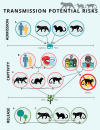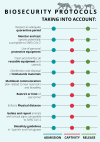Wildlife rehabilitation centers as a potential source of transmission of SARS-CoV-2 into native wildlife of Latin America
- PMID: 34219749
- PMCID: PMC8239512
- DOI: 10.1111/btp.12965
Wildlife rehabilitation centers as a potential source of transmission of SARS-CoV-2 into native wildlife of Latin America
Abstract
The COVID-19 pandemic has impacted the entire world, causing a great number of mortality of humans and affecting the economy, while conservation efforts are finally recognized to prevent further pandemics. The wildlife rehabilitation centers (WRCs) play a relevant role in animal welfare; nevertheless, they also represent an imminent risk of pathogen transmission between humans-to-animals and between animals. Moreover, WRCs could spread pathogens into natural habitats through the reintroduction of infectious individuals. These biosafety concerns at WRCs may increase as the economic and social impact of the COVID-19 extends. We explored the current situation of Latin American WRCs under the COVID-19 pandemic to determine the feasibility of SARS-CoV-2 introduction, amplification, and spread within these institutions. We surveyed WRCs from eight Latin American countries. We found that pandemic is affecting these institutions in many aspects: workers with symptoms compatible with COVID-19, reduced economic resources, and lack of information and support from governmental authorities. These have forced WRCs to reduce the workforce, veterinary visits, and animal food rations and to increase the number of animals released. This scenario generates a risky environment for the transmission of SARS-CoV-2, especially for felids, mustelids, and non-human primates. Therefore, it is imperative to respect quarantine periods, monitor incoming patients, increase biosecurity measures, develop and apply guidelines and recommendations for the protection of personnel and biosafety of enclosures and instruments. It is of utmost importance the proper and safer reintroduction of recovered wildlife.
La pandemia de COVID‐19 ha impactado mundialmente, provocando una alta mortalidad en humanos y afectando la economía, resaltando la importancia de los esfuerzos de conservación para prevenir nuevas pandemias. Los centros de rehabilitación de vida silvestre juegan un papel relevante en el bienestar animal, sin embargo, también representan un riesgo inminente de transmisión de patógenos entre humanos a animales y entre animales. Además, los centros de rehabilitación de vida silvestre podrían propagar patógenos a hábitats naturales mediante la reintroducción de individuos infecciosos. Estas preocupaciones de bioseguridad en centros de rehabilitación de vida silvestre pueden aumentar a medida que se extiende el impacto económico y social del COVID‐19. Exploramos la situación actual de centros de rehabilitación de vida silvestre latinoamericanos durante la pandemia de COVID‐19 para determinar la viabilidad de la introducción, amplificación y propagación del SARS‐CoV‐2 dentro de estas instituciones. Encuestamos centros de rehabilitación de vida silvestre de ocho países latinoamericanos y encontramos que la pandemia está afectando a estas instituciones en muchos aspectos: trabajadores con síntomas compatibles con COVID‐19, recursos económicos reducidos y falta de información y apoyo de las autoridades gubernamentales. Estos han obligado a centros de rehabilitación de vida silvestre a reducir la mano de obra, las visitas veterinarias y las raciones de alimentos para animales, así como aumentar el número de animales liberados. Este escenario genera un entorno de riesgo para la transmisión del SARS‐CoV‐2, especialmente para félidos, mustélidos y primates no humanos. Por lo tanto, es imperativo respetar los períodos de cuarentena, monitorear a los pacientes que ingresan, incrementar las medidas de bioseguridad, desarrollar y aplicar lineamientos y recomendaciones para la protección del personal y la bioseguridad. Es de suma importancia la reintroducción adecuada y segura de la vida silvestre recuperada.
Keywords: COVID‐19; Latin America; SARS‐CoV‐2; conservation; health risks; wildlife rehabilitation centers.
© 2021 The Association for Tropical Biology and Conservation.
Figures


References
-
- Ahmed, W. , Angel, N. , Edson, J. , Bibby, K. , Bivins, A. , O'Brien, J. W. , Choi, P. M. , Kitajima, M. , Simpson, S. L. , Li, J. , Tscharke, B. , Verhagen, R. , Smith, W. J. M. , Zaugg, J. , Dierens, L. , Hugenholtz, P. , Thomas, K. V. , & Mueller, J. F. (2020). First confirmed detection of SARS‐CoV‐2 in untreated wastewater in Australia: A proof of concept for the wastewater surveillance of COVID‐19 in the community. Science of the Total Environment, 728, 138764. - PMC - PubMed
-
- Bosco‐Lauth, A. M. , Hartwig, A. E. , Porter, S. M. , Gordy, P. W. , Nehring, M. , Byas, A. D. , VandeWoude, S. , Ragan, I. K. , Maison, R. M. , & Bowen, R. A. (2020). Experimental infection of domestic dogs and cats with SARS‐CoV‐2: Pathogenesis, transmission and response in cats. PNSA, 117(42), 26382–26388. 10.1073/pnas.2013102117 - DOI - PMC - PubMed
-
- Centers for Disease Control and Prevention . (2020a). Interim guidance for SARS‐CoV‐2 testing in North American wildlife. Centers for Disease Control and Prevention.
-
- Centers for Disease Control and Prevention . (2020b). Evaluation for SARS‐CoV‐2 testing in animals. Centers for Disease Control and Prevention.
LinkOut - more resources
Full Text Sources
Miscellaneous
